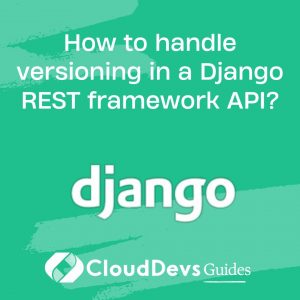Django Q & A
How to use Django with a microservices architecture?
Integrating Django with a microservices architecture can offer flexibility and scalability to your application. Here’s a guide on how to use Django effectively within a microservices setup:
- Decompose Your Application: The first step is to identify the functionalities of your application that can be separated into microservices. Each microservice should have a specific responsibility, and Django can be used to develop one or more of these microservices. For example, you might have a Django microservice for user authentication, another for handling product catalog, and so on.
- Use RESTful APIs: To facilitate communication between microservices, employ RESTful APIs. Django REST framework (DRF) is a natural choice for building these APIs within your Django microservices. DRF allows you to create APIs easily, define serializers, and handle data exchange between services.
- Containerization: Docker and container orchestration tools like Kubernetes can be valuable when working with microservices. Package each Django microservice into a container to ensure consistency and portability across different environments. This allows you to scale services independently.
- API Gateway: Implement an API gateway to manage incoming requests and route them to the appropriate microservice. Tools like Nginx, HAProxy, or custom solutions can serve as gateways to ensure security, load balancing, and routing based on request paths.
- Service Discovery: Use service discovery mechanisms to allow microservices to locate and communicate with each other dynamically. Tools like Consul, etcd, or Kubernetes’ built-in service discovery can help manage this.
- Message Brokers: When microservices need to communicate asynchronously, consider using message brokers like RabbitMQ or Apache Kafka. These can help manage distributed events and data streams.
- Authentication and Authorization: Implement a unified authentication and authorization system that can be shared across microservices. OAuth2, OpenID Connect, or JWT can be used to secure your APIs.
- Logging and Monitoring: Set up centralized logging and monitoring to gain visibility into the performance and health of your microservices. Tools like Prometheus, Grafana, or ELK (Elasticsearch, Logstash, Kibana) can be helpful.
- Data Management: Decide how to handle data consistency across microservices. Options include a shared database (not recommended in many cases), distributed databases like Cassandra, or event-sourcing architectures.
- Testing and CI/CD: Maintain a robust testing strategy for individual microservices and the entire ecosystem. Implement CI/CD pipelines to automate deployment and ensure consistency across microservices.
- Documentation: Create comprehensive documentation for each microservice’s API. Swagger or tools like Postman can help generate interactive API documentation.
- Scaling: Use orchestration tools to scale microservices based on demand. Kubernetes, for instance, can automatically scale containers up or down.
Django can be a valuable part of a microservices architecture when used thoughtfully and in combination with other tools and practices. By following these steps, you can effectively build and manage microservices that work seamlessly together to create a scalable and maintainable application.

Previously at


Argentina

GMT+2
Experienced Full-stack Developer with a focus on Django, having 7 years of expertise. Worked on diverse projects, utilizing React, Python, Django, and more.


